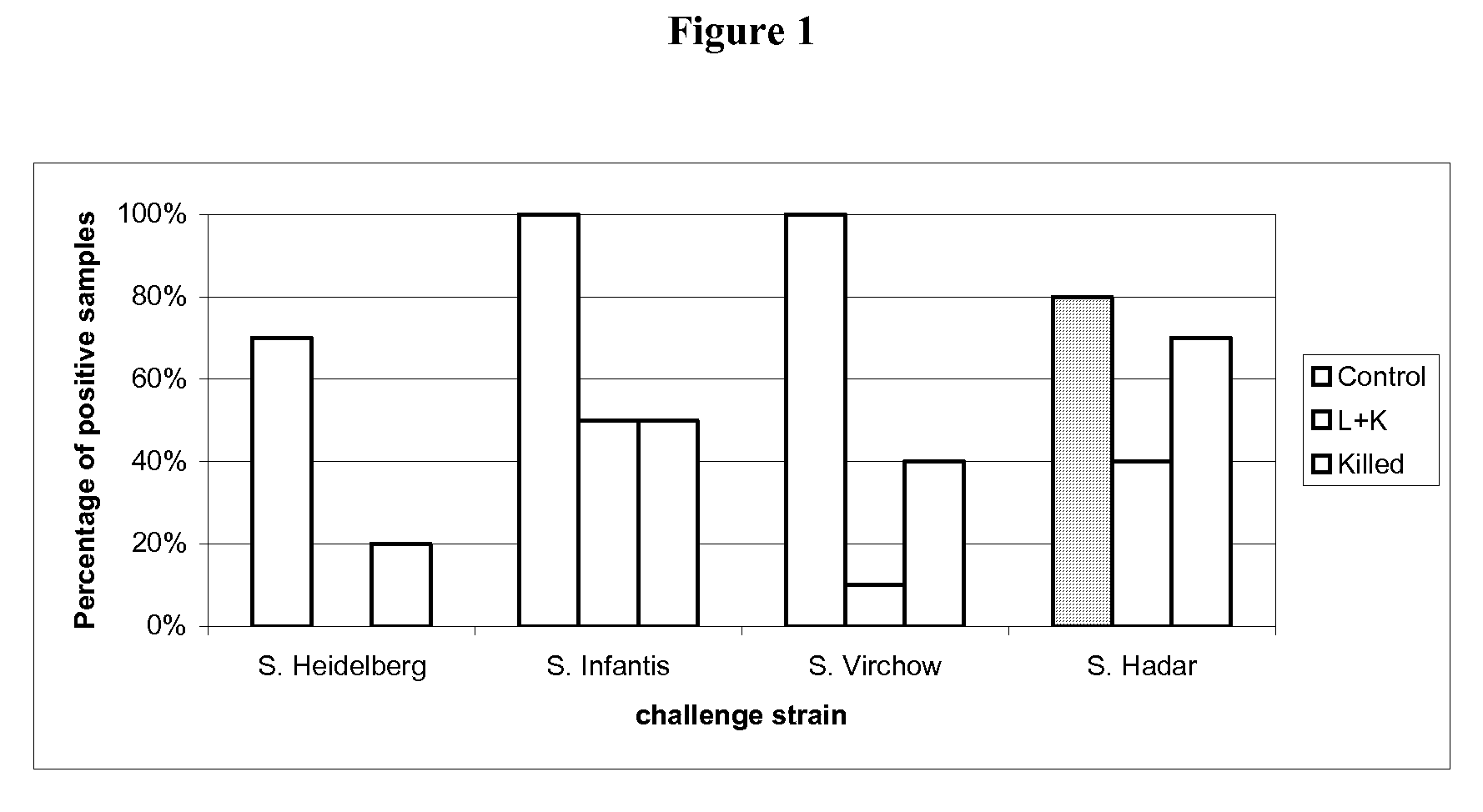Salmonella vaccine
a technology of salmonella and vaccine, applied in the field of salmonella vaccination in animals, can solve the problems of economic loss, less efficient treatment of infection, and risk of suffering salmonellosis
- Summary
- Abstract
- Description
- Claims
- Application Information
AI Technical Summary
Benefits of technology
Problems solved by technology
Method used
Image
Examples
example 1
[0091]For the production of the attenuated vaccine, an adenine / histidine auxotrophic double-marker mutant of Salmonella Enteritidis phage type 4 (PT4) strain, derived through N-methyl-N′-nitro-N-nitrosoguanidine mutagenesis, was used. This strain of Salmonella was named E 3 / 49 strain (Martin G. et al., Berl. Münch. Tierärztl. Wschr., 1996, 109(10): 325-9). The Salmonella E 3 / 49 strain was cultured in nutrient medium containing yeast extract, Tryptone, Na2HPO4×2H2O, MgSO4×7H2O and water for injection, pH 7.6±0.2, for 18-24 hours at 37° C.±1° C. as a non-aerated culture. The cultures were stabilized with 10 vol. % glycerine, filled into containers in aliquots of 1.8 ml and stored at −80° C.±5° C.
[0092]The same nutrient medium added with glucose was used for fermentation of the bacterial strain. The cultures were non-aerated cultures for 8 to 24 hours or shake flask cultures for 8-16 hours at 37° C.±1° C. The inoculum was 0.2-10 vol. %.
[0093]The cultures were stored for +2° C. to +8° C...
example 2
[0099]For the production of the inactivated vaccine, two different strains of Salmonella were used, Salmonella Enteritidis PT 4 strain and Salmonella Typhimurium DT 104 strain.
[0100]Each strain of Salmonella was cultured in trypticase soya broth in soft agar 0.25% (TSA).
[0101]The bacteria obtained were harvested, diluted in water for injection and frozen at a target temperature of −70° C. in bags in the presence of cryoprotectant (20% of glycerol and 5% of sucrose) for storage.
[0102]For the inactivation of Salmonella Enteritidis PT 4 strain, bags containing Salmonella Enteritidis PT 4 strain were thawed, and the bacterial suspension was transferred into a sterile vessel. The inactivating agent, formaldehyde solution 35%, was added at a concentration of 3.88% (formaldehyde solution volume / culture volume) to the bacterial suspension. After blending by stirring, the suspension was transferred into another sterile vessel. The inactivation was carried out under stirring for 24 hours at 2...
example 3
[0108]30 one-day-old SPF (specific pathogen free) chickens were randomly taken on D0 of the study, then assigned to three groups of 10 chickens each.
[0109]The groups are defined as follows:[0110]G.00=control group[0111]G.01=attenuated vaccine of example 1 (1 day of age)+inactivated vaccine of example 2 (21 days of age)[0112]G.02=inactivated vaccine of example 2 (21 days of age)
[0113]After identification, each group was allocated to isolating units till D53.
[0114]On D0, animals of G.01 group were vaccinated with one dose (at least 108 CFU) of attenuated vaccine of example 1 of 0.5 mL by oral route, delivered directly in the oral cavity.
[0115]At D21, the animals of G.01 and G.02 groups were vaccinated with one dose of inactivated vaccine of example 2 by intramuscular route in the left breast muscular deep region, 0.3 mL / dose, Salmonella Enteritidis titre 108.3 CFU per dose before inactivation, Salmonella Typhimurium titre 108 CFU per dose before inactivation.
[0116]The G.01 group was v...
PUM
| Property | Measurement | Unit |
|---|---|---|
| temperature | aaaaa | aaaaa |
| temperature | aaaaa | aaaaa |
| temperature | aaaaa | aaaaa |
Abstract
Description
Claims
Application Information
 Login to View More
Login to View More - R&D
- Intellectual Property
- Life Sciences
- Materials
- Tech Scout
- Unparalleled Data Quality
- Higher Quality Content
- 60% Fewer Hallucinations
Browse by: Latest US Patents, China's latest patents, Technical Efficacy Thesaurus, Application Domain, Technology Topic, Popular Technical Reports.
© 2025 PatSnap. All rights reserved.Legal|Privacy policy|Modern Slavery Act Transparency Statement|Sitemap|About US| Contact US: help@patsnap.com


